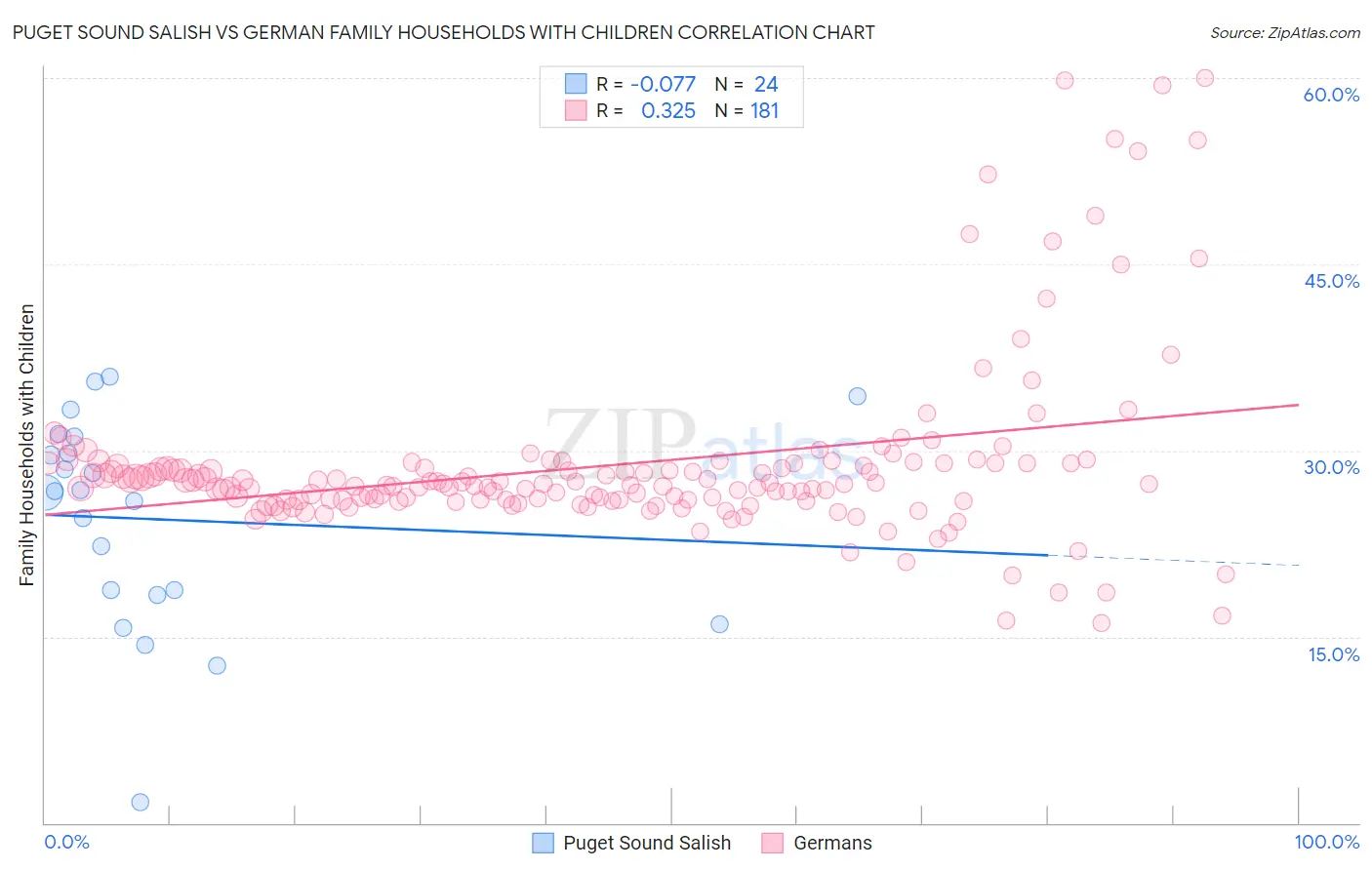Puget Sound Salish vs German Family Households with Children
COMPARE
Puget Sound Salish
German
Family Households with Children
Family Households with Children Comparison
Puget Sound Salish
Germans
27.4%
FAMILY HOUSEHOLDS WITH CHILDREN
46.2/ 100
METRIC RATING
182nd/ 347
METRIC RANK
27.1%
FAMILY HOUSEHOLDS WITH CHILDREN
8.7/ 100
METRIC RATING
224th/ 347
METRIC RANK
Puget Sound Salish vs German Family Households with Children Correlation Chart
The statistical analysis conducted on geographies consisting of 46,155,538 people shows a slight negative correlation between the proportion of Puget Sound Salish and percentage of family households with children in the United States with a correlation coefficient (R) of -0.077 and weighted average of 27.4%. Similarly, the statistical analysis conducted on geographies consisting of 579,972,630 people shows a mild positive correlation between the proportion of Germans and percentage of family households with children in the United States with a correlation coefficient (R) of 0.325 and weighted average of 27.1%, a difference of 1.2%.

Family Households with Children Correlation Summary
| Measurement | Puget Sound Salish | German |
| Minimum | 1.6% | 16.1% |
| Maximum | 36.0% | 60.0% |
| Range | 34.3% | 43.9% |
| Mean | 24.4% | 28.8% |
| Median | 26.7% | 27.3% |
| Interquartile 25% (IQ1) | 18.5% | 26.0% |
| Interquartile 75% (IQ3) | 30.4% | 29.0% |
| Interquartile Range (IQR) | 11.9% | 3.0% |
| Standard Deviation (Sample) | 8.5% | 7.2% |
| Standard Deviation (Population) | 8.3% | 7.2% |
Similar Demographics by Family Households with Children
Demographics Similar to Puget Sound Salish by Family Households with Children
In terms of family households with children, the demographic groups most similar to Puget Sound Salish are Immigrants from Turkey (27.4%, a difference of 0.010%), Aleut (27.4%, a difference of 0.010%), Turkish (27.4%, a difference of 0.020%), South African (27.4%, a difference of 0.030%), and Native Hawaiian (27.4%, a difference of 0.040%).
| Demographics | Rating | Rank | Family Households with Children |
| British | 49.9 /100 | #175 | Average 27.4% |
| Immigrants | China | 49.6 /100 | #176 | Average 27.4% |
| Ugandans | 49.2 /100 | #177 | Average 27.4% |
| Spanish Americans | 48.9 /100 | #178 | Average 27.4% |
| Turks | 46.9 /100 | #179 | Average 27.4% |
| Immigrants | Turkey | 46.9 /100 | #180 | Average 27.4% |
| Aleuts | 46.7 /100 | #181 | Average 27.4% |
| Puget Sound Salish | 46.2 /100 | #182 | Average 27.4% |
| South Africans | 44.9 /100 | #183 | Average 27.4% |
| Native Hawaiians | 44.6 /100 | #184 | Average 27.4% |
| Delaware | 42.0 /100 | #185 | Average 27.4% |
| Immigrants | Brazil | 40.6 /100 | #186 | Average 27.4% |
| Creek | 39.8 /100 | #187 | Fair 27.4% |
| Dutch | 38.8 /100 | #188 | Fair 27.4% |
| Immigrants | Israel | 37.9 /100 | #189 | Fair 27.4% |
Demographics Similar to Germans by Family Households with Children
In terms of family households with children, the demographic groups most similar to Germans are Pima (27.1%, a difference of 0.030%), Paraguayan (27.1%, a difference of 0.050%), New Zealander (27.1%, a difference of 0.060%), Austrian (27.1%, a difference of 0.080%), and Canadian (27.1%, a difference of 0.090%).
| Demographics | Rating | Rank | Family Households with Children |
| U.S. Virgin Islanders | 12.1 /100 | #217 | Poor 27.1% |
| Greeks | 11.4 /100 | #218 | Poor 27.1% |
| Immigrants | Japan | 10.7 /100 | #219 | Poor 27.1% |
| Austrians | 9.9 /100 | #220 | Tragic 27.1% |
| New Zealanders | 9.6 /100 | #221 | Tragic 27.1% |
| Paraguayans | 9.4 /100 | #222 | Tragic 27.1% |
| Pima | 9.2 /100 | #223 | Tragic 27.1% |
| Germans | 8.7 /100 | #224 | Tragic 27.1% |
| Canadians | 7.5 /100 | #225 | Tragic 27.1% |
| Czechoslovakians | 6.6 /100 | #226 | Tragic 27.0% |
| Tsimshian | 6.6 /100 | #227 | Tragic 27.0% |
| Scottish | 6.5 /100 | #228 | Tragic 27.0% |
| Immigrants | Caribbean | 6.3 /100 | #229 | Tragic 27.0% |
| Bulgarians | 5.8 /100 | #230 | Tragic 27.0% |
| Luxembourgers | 5.5 /100 | #231 | Tragic 27.0% |